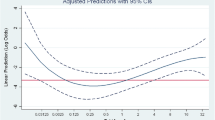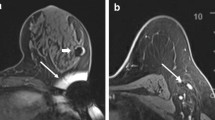Abstract
Background
The wire-guided excision of nonpalpable breast cancer often results in tumor resections with inadequate margins. This prospective, randomized trial was undertaken to investigate whether intraoperative ultrasound (US) guidance enables a better margin clearance than the wire-guided technique in the breast-conserving treatment of nonpalpable breast cancers.
Methods
Patients with a preoperative histological diagnosis of nonpalpable breast cancer that could be visualized both with US and mammography were included. Patients were randomized to undergo either a wire-guided or a US-guided excision. Adequate margins were defined as ≥1 mm.
Results
Of 49 included patients, 23 were assigned to undergo wire-guided excision and 26 to undergo US-guided excision. One patient crossed over to US-guided excision after inadvertent wire displacement. Mean tumor diameter, specimen weight, and operating time were similar in both groups. The excision was adequate in 24 (89%) of 27 US-guided excisions and 12 (55%) of 22 wire-guide excisions (P=.007).
Conclusions
US-guided excision seems to be superior to wire-guided excision with respect to margin clearance of mammographically detected and US-visible nonpalpable breast cancers. Patients do not have to undergo the unpleasant wire placement before surgery.
Similar content being viewed by others
References
Cady B, Stone MD, Schuler JG, et al. The new era in breast cancer. Invasion, size, and nodal involvement dramatically decreasing as a result of mammographic screening.Arch Surg 1996;131:301–8.
O’Higgins N, Linos DA, Blichert-Toft M, et al. European guidelines for quality assurance in the surgical management of mammographically detected lesions.Eur J Surg Oncol, 1998;24:96–8.
Dixon JM, Ravisekar O, Cunningham M, et al. Factors affecting outcome of patients with impalpable breast cancer detected by breast screening.Br J Surg 1996;83:997–1001.
Kaufman CS, Delbecq R, Jacobson L. Excising the reexcision: stereotactic core-needle biopsy decreases need for reexcision of breast cancer.World J Surg 1998;22:1023–7.
Mokbel K, Ahmed M, Nash A, Sacks N. Re-excision operations in nonpalpable breast cancer.J Surg Oncol 1995; 58:225–8.
Smitt MC, Nowels KW, Zdeblick MJ, et al. The importance of the lumpectomy surgical margin status in long-term results of breast conservation.Cancer 1995;76:259–67.
Kelly P, Winslow EH. Needle wire localization for nonpalpable breast lesions: sensations, anxiety levels, and informational needs.Oncol Nurs Forum 1996;23:639–45.
Rahusen FD, Taets van Amerongen AH, van Diest PJ, et al. Ultrasound-guided lumpectomy of nonpalpable breast cancers: a feasibility study looking at the accuracy of obtained margins.J Surg Oncol 1999;72:72–6.
Spivack B, Khanna MM, Tafra L, et al. Margin status and local recurrence after breast-conserving surgery.Arch Surg 1994;129: 952–6.
Gage I, Schnitt SJ, Nixon AJ, et al. Pathologic margin involvement and the risk of recurrence in patients treated with breast-conserving therapy.Cancer 1996;78:1921–8.
Schnitt SJ, Abner A, Gelman R, et al. The relationship between microscopic margins of resection and the risk of local recurrence in patients with breast cancer treated with breast-conserving surgery and radiation therapy.Cancer 1994;74:1746–51.
King TA, Cederbom GJ, Champaign JL, et al. A core breast biopsy diagnosis of invasive carcinoma allows for definitive surgical treatment planning.Am J Surg 1998;176:497–501.
Luini A, Zurrida S, Paganelli G, et al. Comparison of radioguided excision with wire localization of occult breast lesions.Br J Surg 1999;86:522–5.
Berridge DL, Mastey LA, Eckstrom PC, Czarnecki DJ. Indocyanine green dye as a tissue marker for localization of nonpalpable breast lesions.AJR Am J Roentgenol 1995;164:1299.
Kolb TM, Lichy J, Newhouse JH. Occult cancer in women with dense breasts: detection with screening US—diagnostic yield and tumor characteristics.Radiology 1998;207:191–9.
Pamilo M, Soiva M, Anttinen I, et al. Ultrasonography of breast lesions detected in mammography screening.Acta Radiol 1991; 32:220–5.
Ciatto S, Rosselli DT, Catarzi S, Morrone D. The contribution of ultrasonography to the differential diagnosis of breast cancer.Neoplasma 1994;41:341–5.
Rubitt E, Mennemeyer ST, Desmond RA, et al. Reducing the cost of diagnosis of breast carcinoma: impact of ultrasound and imaging-guided biopsies on a clinical breast practice.Cancer 2001;91: 324–32.
Liberman L, Feng TL, Dershaw DD, et al. US-guided core breast biopsy: use and cost-effectiveness.Radiology 1998;208:717–23.
Fornage BD, Ross MI, Singletary SE, Paulus DD. Localization of impalpable breast masses: value of sonography in the operating room and scanning of excised specimens.AJR Am J Roentgenol 1994;163:569–73.
Schwartz GF, Goldberg BB, Rifkin MD, D’Orazio SE. Ultrasonography. An alternative to x-ray-guided needle localization of nonpalpable breast masses.Surgery 1988;104:870–3.
Davies AH, Cowan A, Jones P, et al. Ultrasound localization of screen detected impalpable breast tumours.J R Coll Surg Edinb 1994;39:353–4.
Di Giorgio A, Arnone P, Canavese A. Ultrasound guided excisional biopsy of non-palpable breast lesions: technique and preliminary results.Eur J Surg 1998;164:819–24.
Wilson M, Boggis CR, Mansel RE, Harland RN. Non-invasive ultrasound localization of impalpable breast lesions.Clin Radiol 1993;47:337–8.
Smith LF, Rubio IT, Henry-Tillman R, et al. Intraoperative ultrasound-guided breast biopsy.Am J Surg 2000;180:419–23.
Lind DS, Minter R, Steinbach B, et al. Stereotactic core biopsy reduces the reexcision rate and the cost of mammographically detected cancer.J Surg Res 1998;78:23–6.
Vrieling C, Collette L, Fourquet A, et al. The influence of patient, tumor and treatment factors on the cosmetic results after breast-conserving therapy in the EORTC ‘boost vs. no boost’ trial. EORTC Radiotherapy and Breast Cancer Cooperative Groups.Radiother Oncol 2000;55:219–32.
Harlow SP, Krag DN, Ames SE, Weaver DL. Intraoperative ultrasound localization to guide surgical excision of nonpalpable breast carcinoma.J Am Coll Surg 1999;189:241–6.
Author information
Authors and Affiliations
Corresponding author
Rights and permissions
About this article
Cite this article
Rahusen, F.D., Bremers, A.J.A., Fabry, H.F.J. et al. Ultrasound-guided lumpectomy of nonpalpable breast cancer versus wire-guided resection: A randomized clinical trial. Annals of Surgical Oncology 9, 994–998 (2002). https://doi.org/10.1007/BF02574518
Received:
Accepted:
Issue Date:
DOI: https://doi.org/10.1007/BF02574518




